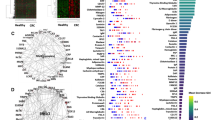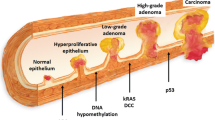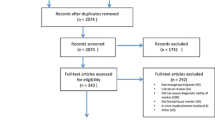Abstract
Background
Fecal occult blood testing (FOBT) has historically relied on methods to detect hemoglobin with no fundamental innovations in decades.
Aim
To examine microRNA (miRNA) as a new marker class for FOBT.
Methods
Candidate miRNA markers were identified by small RNA sequencing of human whole blood compared to colorectal epithelia. Markers were tested in human blood cell subsets and blood from non-human species. We assessed assay linearity in blood spiking and marker stability in stool over incubation experiments. Levels of candidate erythrocyte markers were explored in stools from colorectal cancer (CRC) cases and controls.
Results
Based on small RNA sequencing and validation RT-qPCR, expression level of each of the top blood-enriched markers (hsa-miR-144-3p, 144-5p, 451a, 486-5p, 363-3p, 20b-5p) could perfectly discriminate blood from colorectal epithelia. All six markers arose from and showed specificity to human erythrocytes. Marker levels increased linearly with erythrocyte concentration in saline or stool and demonstrated a broader dynamic range than did immunochemical test for hemoglobin. Degradation of markers occurred in stool but was reduced with preservative buffers. Erythrocyte marker candidates for stool testing were selected in an exploratory set of stools (20 CRC, 40 normal). Candidates were then further tested in a feasibility set (29 CRC, 31 advanced adenoma, and 115 normal); a miRNA panel (hsa-miR-451a, 144-5p, and 200b-3p as normalizer) yielded an AUC of 0.89 (95% CI 0.82–0.95, P < .0001) for CRC.
Conclusions
A novel miRNA-based approach accurately quantifies fecal blood levels over a broad, clinically relevant range.




Similar content being viewed by others
References
Mandel JS, Bond JH, Church TR, et al. Reducing mortality from colorectal cancer by screening for fecal occult blood. Minnesota colon cancer control study. N Engl J Med. 1993;328:1365–1371.
Mandel JS, Church TR, Ederer F, Bond JH. Colorectal cancer mortality: effectiveness of biennial screening for fecal occult blood. J Natl Cancer Inst. 1999;91:434–437.
Ahlquist DA, Young GP. Approach to the patient with occult gastrointestinal bleeding. In: Yamada T, Alpers DH, eds. Principles of clinical gastroenterology. New York: Wiley; 2008:152–169.
Boas I. Die lehre von den okkulten blutungen. Leipzig: G. Thieme; 1914.
Barrows GH, Burton RM, Jarrett DD, Russell GG, Alford MD, Songster CL. Immunochemical detection of human blood in feces. Am J Clin Pathol. 1978;69:342–346.
Harewood GC, McConnell JP, Harrington JJ, Mahoney DW, Ahlquist DA. Detection of occult upper gastrointestinal tract bleeding: performance differences in fecal occult blood tests. Mayo Clin Proc. 2002;77:23–28.
Rockey DC, Auslander A, Greenberg PD. Detection of upper gastrointestinal blood with fecal occult blood tests. Am J Gastroenterol. 1999;94:344–350.
Ahlquist DA, Zou H, Domanico M, et al. Next-generation stool DNA test accurately detects colorectal cancer and large adenomas. Gastroenterology. 2012;142:248–256. (quiz e225–246).
Imperiale TF, Ransohoff DF, Itzkowitz SH, et al. Multitarget stool DNA testing for colorectal-cancer screening. N Engl J Med. 2014;370:1287–1297.
Lidgard GP, Domanico MJ, Bruinsma JJ, et al. Clinical performance of an automated stool DNA assay for detection of colorectal neoplasia. Clin Gastroenterol Hepatol. 2013;11:1313–1318.
Redwood DG, Asay ED, Blake ID, et al. Stool DNA testing for screening detection of colorectal neoplasia in Alaska Native people. Mayo Clin Proc. 2016;91:61–70.
Ahlquist DA, McGill DB, Fleming JL, et al. Patterns of occult bleeding in asymptomatic colorectal cancer. Cancer. 1989;63:1826–1830.
Heigh RI, Yab TC, Taylor WR, et al. Detection of colorectal serrated polyps by stool DNA testing: comparison with fecal immunochemical testing for occult blood (FIT). PLoS ONE. 2014;9:e85659.
Bibbins-Domingo K, Grossman DC, Curry SJ, et al. Screening for colorectal cancer: US preventive services task force recommendation statement. JAMA. 2016;315:2564–2575.
El-Shami K, Oeffinger KC, Erb NL, et al. American cancer society colorectal cancer survivorship care guidelines. CA Cancer J Clin. 2015;65:428–455.
Arroyo JD, Chevillet JR, Kroh EM, et al. Argonaute2 complexes carry a population of circulating microRNAs independent of vesicles in human plasma. Proc Natl Acad Sci USA. 2011;108:5003–5008.
Wu CW, Ng SC, Dong Y, et al. Identification of microRNA-135b in stool as a potential noninvasive biomarker for colorectal cancer and adenoma. Clin Cancer Res. 2014;20:2994–3002.
Friedlander MR, Mackowiak SD, Li N, Chen W, Rajewsky N. miRDeep2 accurately identifies known and hundreds of novel microRNA genes in seven animal clades. Nucleic Acids Res. 2012;40:37–52.
DeLong ER, DeLong DM, Clarke-Pearson DL. Comparing the areas under two or more correlated receiver operating characteristic curves: a nonparametric approach. Biometrics. 1988;44:837–845.
Schwarzenbach H, da Silva AM, Calin G, Pantel K. Data normalization strategies for microRNA quantification. Clin Chem. 2015;61:1333–1342.
Kirschner MB, Edelman JJ, Kao SC, Vallely MP, van Zandwijk N, Reid G. The impact of hemolysis on cell-free microRNA. Biomark Front Genet. 2013;4:94.
Pritchard CC, Kroh E, Wood B, et al. Blood cell origin of circulating microRNAs: a cautionary note for cancer biomarker studies. Cancer Prev Res. 2012;5:492–497.
Wu CW, Ng SS, Dong YJ, et al. Detection of miR-92a and miR-21 in stool samples as potential screening biomarkers for colorectal cancer and polyps. Gut. 2012;61:739–745.
Dore LC, Amigo JD, Dos Santos CO, et al. A GATA-1-regulated microRNA locus essential for erythropoiesis. Proc Natl Acad Sci USA. 2008;105:3333–3338.
Rasmussen KD, Simmini S, Abreu-Goodger C, et al. The miR-144/451 locus is required for erythroid homeostasis. J Exp Med. 2010;207:1351–1358.
Park DI, Ryu S, Kim YH, et al. Comparison of guaiac-based and quantitative immunochemical fecal occult blood testing in a population at average risk undergoing colorectal cancer screening. Am J Gastroenterol. 2010;105:2017–2025.
Acknowledgments
Research support was obtained from Eugene and Eva Lane, Mayo Clinic, Clinical Core of Mayo Clinic Center for Cell Signaling in Gastroenterology (P30DK084567) and Exact Sciences.
Author information
Authors and Affiliations
Corresponding author
Ethics declarations
Conflict of interest
David A. Ahlquist is a scientific advisor to and research collaborator with Exact Sciences. Other authors declared no conflict of interests.
Electronic supplementary material
Below is the link to the electronic supplementary material.
Rights and permissions
About this article
Cite this article
Wu, C.W., Cao, X., Berger, C.K. et al. Novel Approach to Fecal Occult Blood Testing by Assay of Erythrocyte-Specific microRNA Markers. Dig Dis Sci 62, 1985–1994 (2017). https://doi.org/10.1007/s10620-017-4627-6
Received:
Accepted:
Published:
Issue Date:
DOI: https://doi.org/10.1007/s10620-017-4627-6




